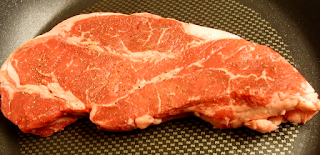19 May 2020
Recipe from The Perfect Cookie, America's Test Kitchen, 2017, p. 46; also available online
I have had store-bought gingersnaps a few times but not many home-made gingersnaps. I recall my daughter making this recipe once some years back. The closest I have made would be spice cookies, and I have made (and written about) several of those. As I slowly work my way through this cookbook I came to this recipe and knew it was time to try it out.
My rule of thumb for the time to make a batch of cookies is 60-90 minutes. This recipe takes longer because the dough rests in the refrigerator for an hour and because it makes more, smaller cookies. Flour, baking soda, and salt were whisked together in a small bowl. Butter was melted in a skillet and cooked until it just started to turn brown. It was poured into a large bowl to which ground ginger, cinnamon, cloves, pepper, and cayenne were added. After a few minutes to cool, brown sugar, grated fresh ginger, and molasses were whisked into the butter mixture followed by egg and egg yolk. The flour mixture was stirred in, the bowl was covered, and refrigerated for about an hour. The dough was formed into balls, each 1 heaping teaspoon. These were rolled in granulated sugar and baked for about 25 minutes. I made 60 cookies (recipe yield is 80). With 50 minutes to make the dough, an hour to chill, and 70 minutes to shape and bake: three hours total time.
These are good cookies. They are crispy with a good snap but are not teeth-shattering hard. This is true for both fresh cookies and after a few days. They freeze well. I would not have been surprised if they were a little soft as mine were larger than envisioned by the recipe writers. (Just how much is a "heaping teaspoon"?) They have good ginger flavor and a bit of late heat, probably from the peppers, but there was not too much spice even for my sensitive, heat-averse taste. These are worth making again.


















